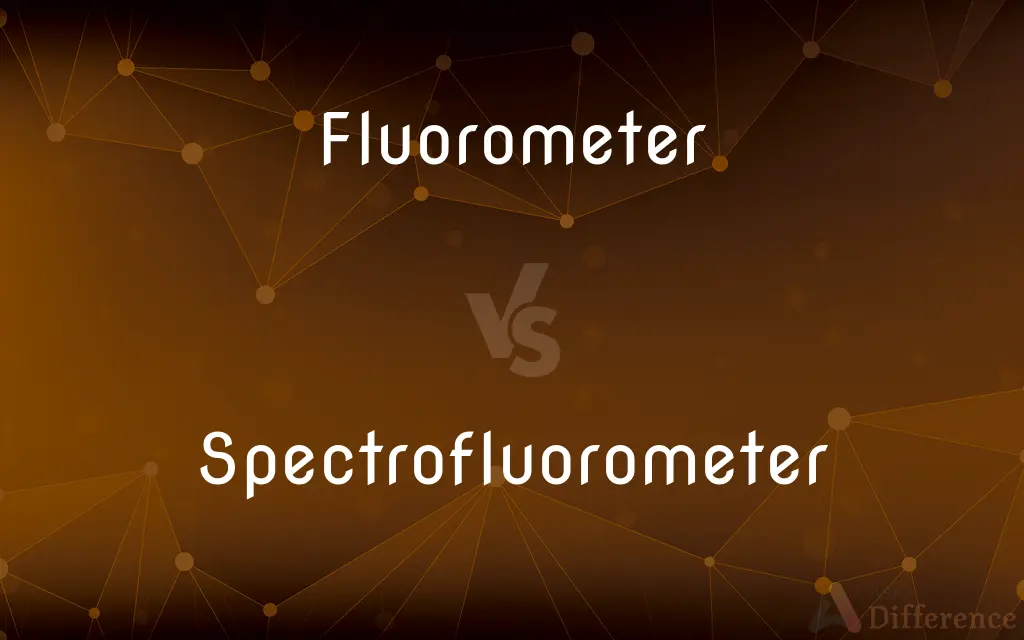Fluorometer vs. Spectrofluorometer — What's the Difference?
Edited by Tayyaba Rehman — By Fiza Rafique — Updated on March 29, 2024
A fluorometer measures the intensity of fluorescence from a sample, while a spectrofluorometer, more advanced, also analyzes the wavelength distribution of fluorescence.

Difference Between Fluorometer and Spectrofluorometer
Table of Contents
ADVERTISEMENT
Key Differences
Fluorometers are instruments designed to detect and measure the intensity of fluorescent light emitted by a sample when excited by a specific wavelength of light. They are primarily used for quantitative analysis of fluorescence. On the other hand, spectrofluorometers not only measure the intensity but also analyze the spectrum of the emitted fluorescence, allowing for a detailed examination of the sample's characteristics.
While fluorometers typically use one or a few select excitation and emission wavelengths, making them suitable for targeted analyses, spectrofluorometers offer the flexibility to scan a range of wavelengths. This makes spectrofluorometers ideal for research applications requiring detailed fluorescence analysis, such as identifying unknown substances or studying complex biological processes.
The simplicity of fluorometers makes them more accessible and cost-effective for routine applications that require rapid and straightforward fluorescence measurements, such as environmental monitoring or clinical diagnostics. Conversely, spectrofluorometers, with their ability to provide comprehensive fluorescence data, are more commonly found in research laboratories where detailed spectral information is crucial.
In terms of application, fluorometers are widely used in fields like biochemistry and environmental science to measure the concentration of fluorescent compounds in a sample. Spectrofluorometers, however, extend their utility to more complex analyses, such as characterizing fluorescent proteins, assessing molecular interactions, and investigating the photophysical properties of materials.
Finally, the choice between a fluorometer and a spectrofluorometer depends on the specific needs of the experiment or analysis. For straightforward, quantitative fluorescence measurements, a fluorometer is often sufficient. However, for in-depth studies requiring detailed spectral information and the ability to analyze multiple emission wavelengths, a spectrofluorometer is the preferred instrument.
ADVERTISEMENT
Comparison Chart
Basic Function
Measures fluorescence intensity
Measures fluorescence intensity and spectrum
Wavelength Flexibility
Limited, often fixed
Broad, adjustable
Application Scope
Quantitative analysis, simple assays
Detailed spectral analysis, research applications
Complexity & Cost
Generally simpler and more cost-effective
More complex and expensive
Typical Use Cases
Environmental monitoring, clinical diagnostics
Research in biochemistry, photophysics
Compare with Definitions
Fluorometer
An instrument that measures the intensity of fluorescence from a sample.
The lab used a fluorometer to quantify the concentration of chlorophyll.
Spectrofluorometer
Allows for detailed fluorescence analysis across a range of wavelengths.
With the spectrofluorometer, we scanned the entire spectrum to identify unknown compounds.
Fluorometer
Cost-effective for routine and high-throughput assays.
Due to budget constraints, the clinic purchased a fluorometer for daily diagnostics.
Spectrofluorometer
An advanced instrument that measures both the intensity and spectrum of fluorescence.
The spectrofluorometer was used to study the emission properties of the new fluorescent protein.
Fluorometer
Primarily used for simple, quantitative fluorescence assays.
The fluorometer provided rapid results for the water quality test.
Spectrofluorometer
Ideal for research requiring comprehensive fluorescence data.
The research team utilized a spectrofluorometer to investigate molecular interactions.
Fluorometer
Essential in fields such as biochemistry and environmental science.
Environmental scientists rely on fluorometers to detect pollutants in water samples.
Spectrofluorometer
More complex and suited for specialized applications.
The lab's spectrofluorometer is indispensable for their photophysical studies.
Fluorometer
Operates at specific excitation and emission wavelengths.
We set the fluorometer to the optimal wavelengths for our dye.
Spectrofluorometer
Used extensively in biochemical and photophysical research.
Spectrofluorometers enable scientists to explore the dynamics of fluorescence in various materials.
Fluorometer
A fluorometer or fluorimeter is a device used to measure parameters of visible spectrum fluorescence: its intensity and wavelength distribution of emission spectrum after excitation by a certain spectrum of light. These parameters are used to identify the presence and the amount of specific molecules in a medium.
Spectrofluorometer
A spectrofluorometer is an instrument which takes advantage of fluorescent properties of some compounds in order to provide information regarding their concentration and chemical environment in a sample. A certain excitation wavelength is selected, and the emission is observed either at a single wavelength, or a scan is performed to record the intensity versus wavelength, also called an emission spectrum.
Fluorometer
An instrument for detecting and measuring fluorescence.
Spectrofluorometer
A spectrometer used in fluorescence spectroscopy
Fluorometer
An instrument used to detect and measure fluorescence.
Common Curiosities
Is a spectrofluorometer always better than a fluorometer?
Not necessarily; the choice depends on the application's requirements. Fluorometers are preferred for simple, quantitative measurements, while spectrofluorometers are chosen for in-depth spectral analysis.
Can a fluorometer identify unknown substances?
Fluorometers are typically used for quantitative analysis and are not ideal for identifying unknown substances without additional spectral data.
Why are spectrofluorometers more expensive than fluorometers?
Spectrofluorometers are more complex, offering broader wavelength scanning and detailed spectral analysis, which contributes to their higher cost.
Can spectrofluorometers measure non-fluorescent compounds?
Spectrofluorometers measure fluorescence; non-fluorescent compounds would not be directly measurable without a fluorescent label or probe.
Can I use a fluorometer for environmental monitoring?
Yes, fluorometers are commonly used for environmental monitoring, such as measuring chlorophyll or pollutant concentrations in water.
How do I choose between a fluorometer and a spectrofluorometer?
The choice should be based on your specific needs: simplicity and cost-efficiency for routine assays with a fluorometer, or detailed spectral analysis for research applications with a spectrofluorometer.
What is the main difference between a fluorometer and a spectrofluorometer?
The main difference is that a fluorometer measures fluorescence intensity at specific wavelengths, while a spectrofluorometer can also analyze the fluorescence spectrum.
What applications benefit the most from using a spectrofluorometer?
Applications that require detailed analysis of fluorescence properties, such as studying molecular interactions, characterizing fluorescent proteins, or investigating material photophysics, benefit the most from spectrofluorometers.
Are fluorometers easy to use?
Yes, fluorometers are generally simpler and more user-friendly, designed for straightforward quantitative fluorescence measurements.
Do both instruments require specialized training?
While both instruments require some training, spectrofluorometers typically need more specialized knowledge to fully utilize their advanced capabilities.
Share Your Discovery

Previous Comparison
Kurdish vs. Turkish
Next Comparison
Pear vs. PearlAuthor Spotlight
Written by
Fiza RafiqueFiza Rafique is a skilled content writer at AskDifference.com, where she meticulously refines and enhances written pieces. Drawing from her vast editorial expertise, Fiza ensures clarity, accuracy, and precision in every article. Passionate about language, she continually seeks to elevate the quality of content for readers worldwide.
Edited by
Tayyaba RehmanTayyaba Rehman is a distinguished writer, currently serving as a primary contributor to askdifference.com. As a researcher in semantics and etymology, Tayyaba's passion for the complexity of languages and their distinctions has found a perfect home on the platform. Tayyaba delves into the intricacies of language, distinguishing between commonly confused words and phrases, thereby providing clarity for readers worldwide.
















































